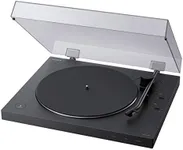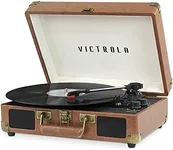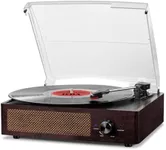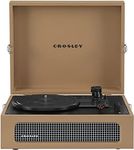Buying Guide for the Best Turntables With Speakers
Choosing a turntable with built-in speakers is a great way to enjoy vinyl records without needing a separate sound system. When shopping for one, it's important to consider how you'll use it—whether for casual listening, as a centerpiece for your living room, or for more serious music enjoyment. Think about where you'll place it, how much space you have, and what kind of music experience you want. Understanding the key features will help you find a turntable that matches your needs and gives you the best listening experience.Drive TypeThe drive type refers to how the turntable's platter is powered. The two main types are belt-drive and direct-drive. Belt-drive turntables use a rubber belt to spin the platter, which helps reduce vibrations and is often preferred for home listening. Direct-drive turntables have the motor directly under the platter, offering more consistent speed and are favored by DJs for their quick start and stop. If you want a quieter, more traditional listening experience, belt-drive is usually best. If you plan to do any DJing or want a more robust, low-maintenance option, direct-drive might suit you better.
Built-in Speaker QualityThe quality of the built-in speakers determines how good your records will sound straight out of the box. Some turntables have small, basic speakers that are fine for background music, while others offer larger, more powerful speakers for a fuller sound. If you want to fill a room or enjoy richer audio, look for turntables with larger or higher-quality speakers. If you just want something for casual, close-up listening, even basic speakers may be enough.
Speed SettingsTurntables can play records at different speeds, usually 33 1/3, 45, and sometimes 78 RPM. This is important because different records are made to be played at different speeds. Most modern albums use 33 1/3 RPM, singles often use 45 RPM, and older records may use 78 RPM. Make sure the turntable you choose supports the speeds of the records you own or plan to buy. If you have a mix of old and new records, a model with all three speeds is most versatile.
Cartridge and Stylus TypeThe cartridge and stylus are the parts that actually touch the record and read the music. Some turntables come with a basic, fixed cartridge, while others allow you to upgrade or replace it. A better cartridge and stylus can improve sound quality and reduce wear on your records. If you’re just starting out, a fixed, pre-installed cartridge is fine. If you want to upgrade your sound later, look for a turntable with a replaceable cartridge.
Connectivity OptionsConnectivity refers to how you can connect your turntable to other devices. Some turntables offer Bluetooth, allowing you to play music wirelessly through other speakers or headphones. Others have RCA or AUX outputs for connecting to external speakers or amplifiers. If you want flexibility to upgrade your sound system in the future, or play music through different devices, look for a turntable with multiple connectivity options.
Automatic vs. Manual OperationTurntables can be fully manual, semi-automatic, or fully automatic. Manual turntables require you to place the tonearm on the record and lift it off when finished. Semi-automatic models return the tonearm automatically at the end of a record, while fully automatic ones handle both starting and stopping. If you want a hands-on, traditional experience, manual is the way to go. If you prefer convenience and less risk of damaging your records, semi-automatic or automatic models are easier to use.
Portability and SizeThe size and weight of a turntable with speakers can vary a lot. Some are compact and easy to move, making them great for small spaces or taking to different rooms. Others are larger and designed to stay in one place for better sound quality. Think about where you’ll use your turntable most and whether you need to move it around. If space is tight or you want to take it with you, a smaller, lighter model is best. For a more permanent setup and better sound, a larger unit may be preferable.












